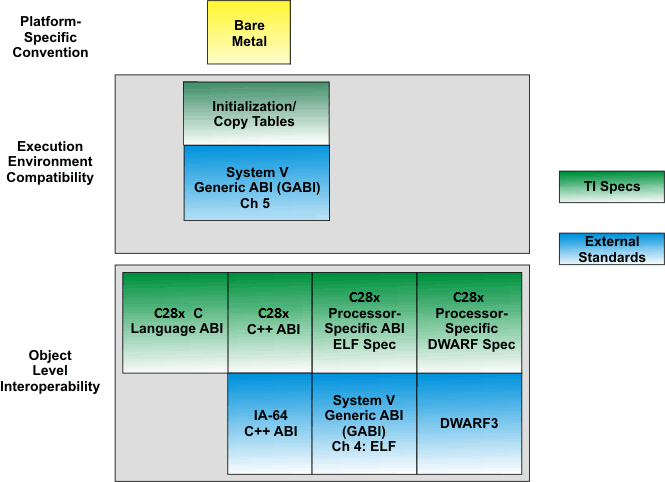SPRAC71B February 2019 – October 2023
- 1
- 1 Introduction
- 2 Data Representation
-
3 Calling Conventions
- 3.1 Call and Return
- 3.2 Register Conventions
- 3.3 Argument Passing
- 3.4 Return Values
- 3.5 Structures and Unions Passed and Returned by Reference
- 3.6 Conventions for Compiler Helper Functions
- 3.7 Prolog and Epilog Helper Functions
- 3.8 Scratch Registers for Functions Already Seen
- 3.9 Interrupt Functions
- 4 Data Allocation and Addressing
- 5 Code Allocation and Addressing
- 6 Helper Function API
-
7 Standard C Library API
- 7.1 About Standard C Libraries
- 7.2 Reserved Symbols
- 7.3 <assert.h> Implementation
- 7.4 <complex.h> Implementation
- 7.5 <ctype.h> Implementation
- 7.6 <errno.h> Implementation
- 7.7 <float.h> Implementation
- 7.8 <inttypes.h> Implementation
- 7.9 <iso646.h> Implementation
- 7.10 <limits.h> Implementation
- 7.11 <locale.h> Implementation
- 7.12 <math.h> Implementation
- 7.13 <setjmp.h> Implementation
- 7.14 <signal.h> Implementation
- 7.15 <stdarg.h> Implementation
- 7.16 <stdbool.h> Implementation
- 7.17 <stddef.h> Implementation
- 7.18 <stdint.h> Implementation
- 7.19 <stdio.h> Implementation
- 7.20 <stdlib.h> Implementation
- 7.21 <string.h> Implementation
- 7.22 <tgmath.h> Implementation
- 7.23 <time.h> Implementation
- 7.24 <wchar.h> Implementation
- 7.25 <wctype.h> Implementation
-
8 C++ ABI
- 8.1 Limits (GC++ABI 1.2)
- 8.2 Export Template (GC++ABI 1.4.2)
- 8.3 Data Layout (GC++ABI Chapter 2)
- 8.4 Initialization Guard Variables (GC++ABI 2.8)
- 8.5 Constructor Return Value (GC++ABI 3.1.5)
- 8.6 One-Time Construction API (GC++ABI 3.3.2)
- 8.7 Controlling Object Construction Order (GC++ ABI 3.3.4)
- 8.8 Demangler API (GC++ABI 3.4)
- 8.9 Static Data (GC++ ABI 5.2.2)
- 8.10 Virtual Tables and the Key function (GC++ABI 5.2.3)
- 8.11 Unwind Table Location (GC++ABI 5.3)
-
9 Exception Handling
- 9.1 Overview
- 9.2 PREL31 Encoding
- 9.3 The Exception Index Table (EXIDX)
- 9.4 The Exception Handling Instruction Table (EXTAB)
- 9.5 Unwinding Instructions
- 9.6 Descriptors
- 9.7 Special Sections
- 9.8 Interaction With Non-C++ Code
- 9.9 Interaction With System Features
- 9.10 Assembly Language Operators in the TI Toolchain
- 10DWARF
- 11ELF Object Files (Processor Supplement)
- 12ELF Program Loading and Linking (Processor Supplement)
- 13Build Attributes
- 14Copy Tables and Variable Initialization
- 15Revision History
1.2 Scope
Figure 1-1 shows the components of the ABI and their relationship. We will briefly describe the components, beginning with the lower part of the diagram and moving upward, and provide references to the appropriate chapter of this ABI specification.
The components in the bottom area relate to object-level interoperability.
 Figure 1-1 Parts of
the ABI Specification
Figure 1-1 Parts of
the ABI SpecificationThe C Language ABI (Chapter 2, Chapter 3, Chapter 4, Chapter 5, Chapter 6 and Chapter 7) specifies function calling conventions, data type representations, addressing conventions, and the interface to the C run-time library.
The C++ ABI (Chapter 8) specifies how the C++ language is implemented; this includes details about virtual function tables, name mangling, how constructors are called, and the exception handling mechanism (Chapter 9). The C28x C++ ABI is based on the prevalent IA-64 (Itanium) C++ ABI.
The DWARF component (Chapter 10) specifies the representation of object-level debug information. The base standard is the DWARF3 standard. This specification details processor-specific extensions.
The ELF component (Chapter 11) specifies the representation of object files. This specification extends the System V ABI specification with processor specific information.
Build Attributes (Chapter 13) refer to a means of encoding into an object file various parameters that affect inter-object compatibility, such as target device assumptions, memory models, or ABI variants. Toolchains can use build attributes to prevent incompatible object files from being combined or loaded.
The components in the central area of the diagram relate to execution-time interoperability.
The components in the top part of Figure 1-1 augment the ABI with platform-specific conventions that define the requirements for executables to be compatible with an execution environment, such as the number and use of program segments, addressing conventions, visibility conventions, pre-emption, program loading, and initialization. Bare-Metal refers to the absence of any specific environment.
Finally, there is a set of specifications that are not formally part of the ABI but are documented here both for reference and so that other toolchains can optionally implement them.
Initialization (Chapter 14) refers to the mechanism whereby initialized variables obtain their initial value. Nominally these variables reside in the .data section and they are initialized directly when the .data section is loaded, requiring no additional participation from the tools. However the TI toolchain supports a mechanism whereby the .data section is encoded into the object file in compressed form, and decompressed at startup time. This is a special use of a general mechanism that programmatically copies compressed code or data from offline storage (e.g. ROM) to its execution address. We refer to this facility as copy tables. While not part of the ABI, the initialization and copy table mechanism is documented here so that other toolchains can support it if desired.